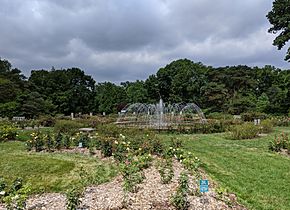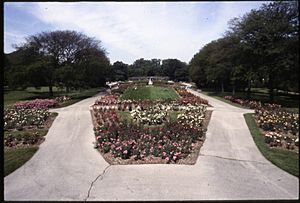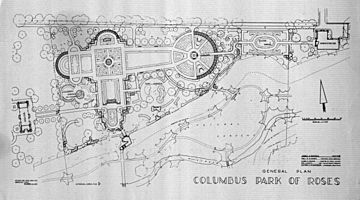Columbus Park of Roses facts for kids
Quick facts for kids Columbus Park of Roses |
|
|---|---|
| Whetstone Park of Roses | |

The park's Formal Rose Garden
|
|
| Location | 3923 North High Street, Columbus, Ohio |
| Area | 13 acres (5.3 ha) |
| Established | April 19, 1952 |
| Designer | Ray Dietz, Eugene Rosebrook, George Tobey |
| Administered by | Columbus Recreation and Parks Department |
| Plants | 11,000 roses of 350 varieties |
| Parking | Surface lot |
| Public transit access | |
The Columbus Park of Roses is a beautiful public park and rose garden in Columbus, Ohio. It's also known as the Whetstone Park of Roses. You can find it inside the bigger Whetstone Park, in the Clintonville area of the city.
Contents
Exploring the Park of Roses
The Columbus Park of Roses is a huge garden, covering about 13-acre (5.3 ha). It's one of the biggest public rose gardens in the United States. Imagine this: the park has around 11,000 rose plants! These roses come in 350 different types, which is a lot of variety.
This special rose park is part of the even larger Whetstone Park. Whetstone Park is 148-acre (60 ha) in size. Both parks are managed by the Columbus Recreation and Parks Department. The best part is, it's free to visit! You can explore the park from 7 a.m. until dusk, any day of the year.
Besides all the amazing flowers, the park has other cool features. There are picnic spots where you can have lunch with friends or family. You can also find a shelterhouse, which people can reserve for parties or even weddings. If you like to walk, there's a nice walking trail. Plus, there are peaceful forest areas to explore.
The park also has a small outdoor theater and a pretty gazebo. The gazebo is quite old; it was built way back in 1878! It used to be at a military base called Fort Hayes. In 1975, it was moved to the Park of Roses and fixed up. During the summer, a group called the Civitan Club of North Columbus holds free concerts there.
Many things in the park have been given as gifts. These include a sundial (a type of clock that uses the sun), a plaque with a poem, comfy park benches, and even some of the rose bushes themselves.
Different Garden Areas
The Park of Roses has several unique garden areas to discover:
- The Formal Rose Garden: This garden has rose beds arranged in a neat, balanced way. Each bed has only one type of rose.
- The Heritage Rose Garden: Here, you'll find older types of roses. These roses were grown before 1867, which is when modern roses started to become popular.
- The Perennial Garden: This garden is full of plants that come back year after year. It has about 100 different kinds of perennials, bulbs, shrubs, and trees.
- The Herb Garden: This section features about 100 different herbs and useful plants. They are grouped by how they are used, like for cooking or making tea.
- The Backyard Garden: This garden shows off plants that are easy to take care of. It gives visitors ideas for their own home gardens.
- The Arboretum: This is a collection of trees spread throughout the park. It has about 138 different types of trees and shrubs.
Rose Gardens to See
The Formal Rose Garden was the very first part of the park to be planted, back in 1953. It was designed to look like a fancy Italian garden, with neat, matching hedges. Each rose bed in this garden has only one kind of rose, with no other flowers or trees mixed in. This garden is huge, covering 7 of the park's 13 acres! It's home to about 11,000 roses, including popular types like floribunda, grandiflora, and hybrid tea roses.
At the east end of the Formal Rose Garden, there's a cool observation tower. It was added in the 1980s and lets you get a great view of the garden. In the middle of the garden, you'll see a beautiful fountain. It was put in place in 1957 and was updated in 2012. The fancy stone and iron fence at the garden's west entrance was finished in 2017.
The Heritage Rose Garden shows off roses that were grown before 1867. This year is important because it's considered the start of "modern" roses. This garden was officially opened in 1986. Some of the old-fashioned roses you might see here include centifolias, damasks, gallicas, and rugosas.
Other Plant Collections
The Perennial Garden is located south of the Formal Rose Garden. It has eight big plant beds and about 100 different kinds of plants that grow back each year. These include bulbs, trees, and shrubs. The plants in this garden change throughout the year, thanks to Ohio's long growing season from March to November. This garden was part of the park's original plan but wasn't finished until the early 1970s. Since 1997, the Northview Buckeye Garden Club has helped plan and take care of it.
Just east of the Perennial Garden is the Herb Garden. It has about 100 different herbs and plants that are useful for many things. The plants are grouped into nine themes, like culinary (for cooking), tea, medicinal (for health), and pollinator (for attracting bees and butterflies). The Herb Garden was created in 1976. This happened after really cold winters damaged many of the roses that were first planted there. The Columbus Horticultural Society has been planning and caring for this garden since it opened.
The Backyard Garden is in the northwest part of the park. It has many different bulbs, perennials, shrubs, and pretty trees. The idea is to give visitors ideas for their own gardens at home. This garden was developed between 2007 and 2009. It was originally meant to test roses that don't need much care, like fertilizers or extra water. Now, it includes other plants that are easy to maintain and good for the environment.
The Arboretum is a large collection of trees. It's one of the park's features that you can enjoy all year round. It has about 138 different kinds of trees and shrubs. The Arboretum also provides a natural home for many birds that live in Ohio, as well as birds that migrate through, and important insects like pollinators.
History of the Park of Roses
Around 1946, people started talking about creating a rose garden at Columbus City Hall. That idea didn't happen, but it got people excited about a rose park. In 1951, members of the Columbus Rose Club and the Central Ohio Rose Society formed a group to make the park a reality. The park was officially started on April 19, 1952.
At this time, a group of eleven people called the Columbus Rose Commission began giving advice to the parks department about the Park of Roses. In May, the city's park and forestry department started designing it. The main designers were Ray S. Dietz, Eugene A. Rosebrook, and George B. Tobey, Jr. About 2,000 hybrid tea roses were planted in the fall of 1952. Most of the other plants were put in the ground between late March and April 1953.
The park first opened to the public on June 6, 1953. All the paths and gardens were ready, and a fence surrounded the area. When it opened, the garden had 20,000 plants! The park had its official dedication ceremony on September 13 of that year. Back then, the larger Whetstone Park, which surrounds the rose garden, was the biggest park in Columbus, covering 100 acres. The Park of Roses used 13.5 acres of this land, plus another 35 acres that included forests and a natural ravine.
By 1956, the park had grown even more, with 32,000 plants and 425 different types of roses. At this time, it also had a collection of flowering crab apple trees. There were even plans to add gardens for lilacs and a special garden just for children.
For a while, the main office of the American Rose Society was located in the park. This office had the largest library of rose books in the world!
The Park of Roses Foundation was created in February 1986. This group helps manage donations to the park. It was formed after very cold winters in the mid-1970s killed almost half of the park's rose bushes.
The park was not part of AmeriFlora '92, a big international flower show held in Columbus in 1992. Some people thought that the Park of Roses and the Ohio State Fair might have made the show less successful. This was because the Park of Roses was free to enter, and the fair only cost $5.
Images for kids






